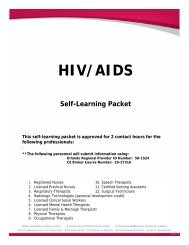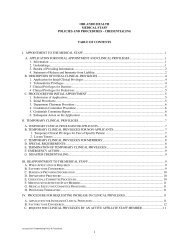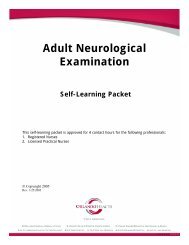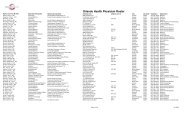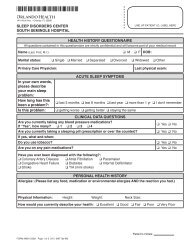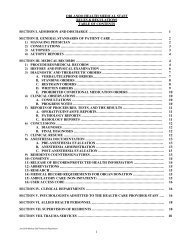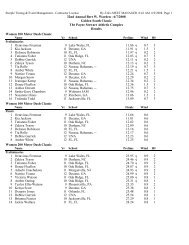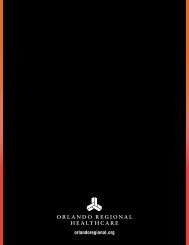Advanced Hemodynamics - Orlando Health
Advanced Hemodynamics - Orlando Health
Advanced Hemodynamics - Orlando Health
Create successful ePaper yourself
Turn your PDF publications into a flip-book with our unique Google optimized e-Paper software.
<strong>Advanced</strong> Hemodynamic Monitoring<br />
Hemodynamic Applications<br />
These cases will provide the opportunity to see how advanced hemodynamic monitoring may<br />
assist in determining appropriate interventions for different situations.<br />
Case 1<br />
You are caring for a 29-year old male motor cycle crash patient with a BP of 74/30, heart rate<br />
of 52. What should you do about his hypotension? You can’t be sure without knowing the<br />
reason for it. In addition, the CVP reading is 1 mm Hg. This additional information indicates<br />
that the patient has a diminished blood volume returning to the right heart, but still doesn’t tell<br />
you what interventions should receive the highest priority. Further assessment reveals that the<br />
patient sustained a C 7 fracture with severe extremity weakness noted. You now correctly<br />
determine that the patient is in neurogenic shock, causing a loss of vasomotor tone, and that he<br />
is hypotensive not because he has lost blood volume, but because neurogenic shock results in<br />
massive vasodilation (decreased SVR), decreased blood return to the right atrium and<br />
bradycardia. Note the patient’s pulse pressure; it is wide, indicating arterial vasodilation.<br />
Oxygen delivery (DO2) and oxygen consumption (VO2) most likely will not be changed.<br />
Stroke Volume Variation (SVV) in this case would be high, and can be used to guide your fluid<br />
resuscitation. Considering the evident cause of his hypotension and bradycardia, advanced<br />
hemodynamic monitoring is not immediately indicated. Taking all the data into consideration<br />
allows you to intervene appropriately with a vasoconstrictor and IV fluids to fill the vascular<br />
space.<br />
Case 2<br />
You are caring for a 79-year old male patient with a BP of 84/40, temperature 104° F (40º C),<br />
heart rate 120 bpm, and SaO2 90% on 4 liters NC. He is admitted from a nursing home with<br />
pneumonia. What is causing his hypotension? Note that the pulse pressure is wide, indicating<br />
vasodilation and decreased left ventricular afterload. Additional information includes a CVP<br />
reading of 1 mm Hg. What does this tell us? Only that we have a decreased right ventricular<br />
end diastolic pressure/volume. Severe dehydration, blood loss, spinal shock and vasogenic<br />
shock can reveal the same findings. However, we suspect that this patient is in early septic<br />
shock considering his pneumonia and fever which also causes vasodilation (decreased SVR)<br />
and a decreased preload. Further assessment reveals lung sounds include bilateral rhonchi, and<br />
laboratory results show leucocytosis. This rules the patient in for severe sepsis. Upon<br />
examining peripheral pulses, we note them to be bounding and skin turgor is poor. The cardiac<br />
output will be high as the patient is in a hyperdynamic state. If oximetric measurements are<br />
available, expect the SVO2/ScVO2 to be either high because oxygenated blood is being<br />
shunted away and not being utilized by the tissues, or it could be low because of higher oxygen<br />
consumption (VO2). Oxygen delivery (DO2) is probably normal. If the patient would be on a<br />
ventilator and pulse contour analysis would be applied it would show a high Stroke Volume<br />
Variation (SVV) because of the decreased preload volume. This patient will need to be fluid<br />
resuscitated to improve preload and antibiotics need to be initiated. Ventilatory support and<br />
possible inotropic support can be indicated if the condition deteriorates.<br />
Copyright 2010 <strong>Orlando</strong> <strong>Health</strong>, Education & Development 38



